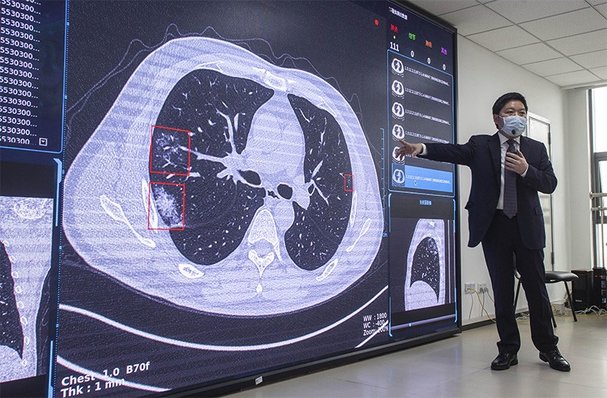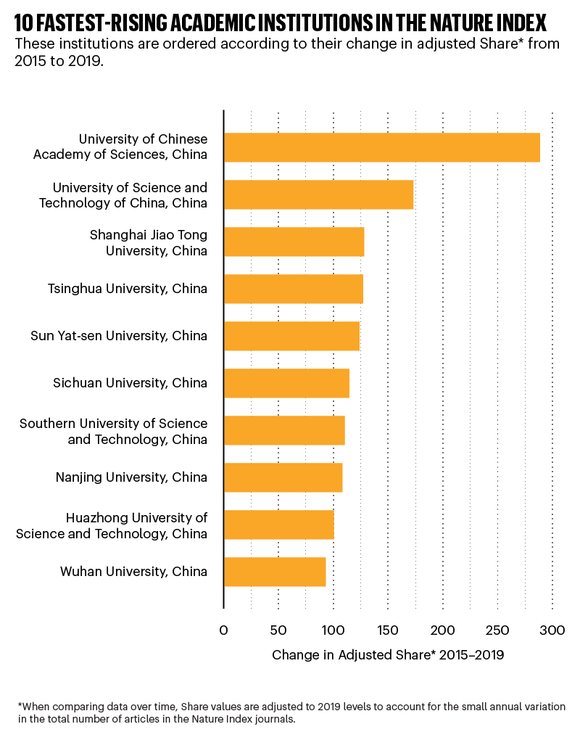
The West China Hospital of Sichuan University uses a scan-reading artificial-intelligence system to help process CT scans.
Credit: Wang Lei/China News Service/Visual China Group/Getty
Fast-rising academic institutions in the Nature Index 2020 Annual Tables
These institutions have achieved significant increases in overall research output in the Nature Index since 2015.
30 April 2020

Wang Lei/China News Service/Visual China Group/Getty
The West China Hospital of Sichuan University uses a scan-reading artificial-intelligence system to help process CT scans.
Chinese institutions dominate academic institutions with the strongest growth in the Nature Index, occupying places 1 through to 43 in our 2020 Annual Tables (see Graphic).
The University of Chinese Academy of Sciences (UCAS) in Beijing is the fastest rising academic institution, with a change in adjusted Share from 2015 to 2019 of 288.61, an increase of 242%. (When comparing data over time, Share values are adjusted to 2019 levels to account for the small annual variation in the total number of articles in the Nature Index journals.)
UCAS has almost double the article Count of the Hefei-based University of Science and Technology of China (USTC), which is in second position. (A Count of one is assigned to an entity, such as an institution or country, if one or more authors of the research article are from that entity, regardless of how many co-authors there are from outside that entity. The Nature Index is one indicator of institutional research performance. See Editor’s note below.)
See the 2020 Annual Tables Top 100 rising academic institutions for 2019.

Here is a selection of institutions from the top 25 of the Nature Index 2020 Annual Tables — rising academic institutions.
Sichuan University, China
Change in adjusted Share (2015–19): 114.65; % change: 107.4%; Place: 6th
The Chengdu-based Sichuan University (SCU) is the oldest modern university in southwest China. Founded in 1896, it was bolstered by a merger with the Chengdu University of Science and Technology in 1994 and with the prestigious West China University of Medical Sciences in 2000.
In 2019, it had enrolled 37,000 undergraduate, 28,000 graduate, and 4,200 international students. Among its 4,527 faculty members, it hosts 16 members of the Chinese Academy of Sciences and Chinese Academy of Engineering, 45 full-time Changjiang scholars honoured by China’s Ministry of Education, and 51 recipients of the Distinguished Young Scientist award from the National Natural Science Foundation of China.
Also placed third in the fastest-rising institutions in chemistry in the Nature Index 2020 Annual Tables, SCU has a strong and rapidly growing team of chemistry researchers, distributed throughout its College of Chemistry, School of Chemical Engineering and other research centres.
The 15 national key laboratories and engineering centres hosted by the university focus on areas such as polymer materials, green chemistry, leather chemistry and biopharmaceuticals.
Wuhan University, China
Change in adjusted Share (2015–19): 93.25; % change: 75.3%; Place: 10th
Located in Wuhan, the capital city of Hubei in central China, Wuhan University (WHU) is one of China's oldest institutions of higher learning, set up by the reformist bureaucrat, Zhang Zhidong, in 1893.
It grew significantly in 2000, when it merged with the Wuhan University of Hydraulic and Electrical Engineering, the Wuhan Technical University of Surveying and Mapping, and Hubei Medical University, and is today one of China’s most prestigious universities, with strengths in basic research, engineering, medical sciences and social sciences.
As of June 2019, WHU had 29,405 undergraduate, 26,862 graduate, and 2,162 international students. Among its 3,770 faculty members, 18 are members of the Chinese Academy of Sciences and Chinese Academy of Engineering, and 65 are recipients of the Distinguished Young Scientist award from the National Natural Science Foundation of China.
The university hosts four State Key Laboratories — facilities that receive funding and administrative support from the Chinese government — and two state engineering research centres.
As of June 2019, the WHU School of Physics and Technology had earned nearly 250 million yuan (US$35.2 million) in research grants.
Nanjing Tech University, China
Change in adjusted Share (2015–19): 79.52; % change: 274.1%; Place: 12th
Located in Nanjing, the second-largest city in eastern China and the capital city of the coastal Jiangsu Province, Nanjing Tech University (NanjingTech) was established in 2001 through a merger of the Nanjing University of Chemical Technology and Nanjing Institute of Architecture and Civil Engineering.
As for many other universities in Nanjing, a city with a population of 8.5 million, the university’s history can be traced back to the National Central University, the parent of Nanjing University, which was established in 1902 and known formerly as the Sanjiang Normal School. Today NanjingTech has around 30,000 students and about 3,000 faculty members, including 8 members of the Chinese Academy of Sciences and Chinese Academy of Engineering.
NanjingTech has long been known for its strength in industrial-engineering research and education in China. In the field of chemical engineering, it was one of 7 A-level universities ranked by China’s Ministry of Education in 2017.
In 2019, NanjingTech was in the global 1% of most highly cited papers in chemistry, materials science, engineering and biochemistry, according to Web of Science’s Essential Science Indicators database.
Soochow University, China
Change in adjusted Share (2015–19): 77.21; % change: 50.8%; Place: 13th
Situated in Suzhou, 100 kilometres west of Shanghai, Soochow University's output is dominated by chemistry and the physical sciences, which account for more than 90% of the university's research in journals tracked by the Nature Index.
One of Soochow University's most prolific research centres is the Institute of Functional Nano & Soft Materials, which has received more than US$100 million in funding since 2008 and accounts for roughly 28% of the university's output in the Nature Index.
Soochow hosts a synchrotron radiation centre for biomedical and materials research, as part of its collaboration with Canada’s Western University in London, Ontario. The partnership also includes a joint PhD programme.
The university has several affiliated hospitals, and a children's hospital that opened a new main building in 2015, bordered by gardens and canals — two signature features of the city of Suzhou.
South China University of Technology, China
Change in adjusted Share (2015–19): 57.15; % change: 88.2%; Place: 18th
Located in Guangzhou, the capital of the Guangdong province and the third-largest city in mainland China, with a population of 14 million, the South China University of Technology (SCUT) sits in the heart of one of the country’s biggest economic centres.
In 2019, SCUT had enrolled 25,177 undergraduate, 16,399 graduate, and 1,063 international students, and had a faculty team of 3,188.
With most of its nine State Key Laboratories and technological centres focused on engineering and industrial technologies, SCUT has achieved significant advances in basic research in recent years. In 2018, its papers in engineering, materials science, chemistry, and agricultural science were ranked in the global top 1%, by measure of citations, according to Web of Science.
This story is part of Nature Index 2020 Annual Tables. See more stories here.
For a description of the terminology and methodology used in this supplement, please see our guidelines here.
Editor’s note: The Nature Index is one indicator of institutional research performance. The metrics of Count and Share used to order Nature Index listings are based on an institution’s or country’s publication output in 82 natural-science journals, selected on reputation by an independent panel of leading scientists in their fields. Nature Index recognizes that many other factors must be taken into account when considering research quality and institutional performance; Nature Index metrics alone should not be used to assess institutions or individuals. Nature Index data and methods are transparent and available under a creative commons licence at natureindex.com.
